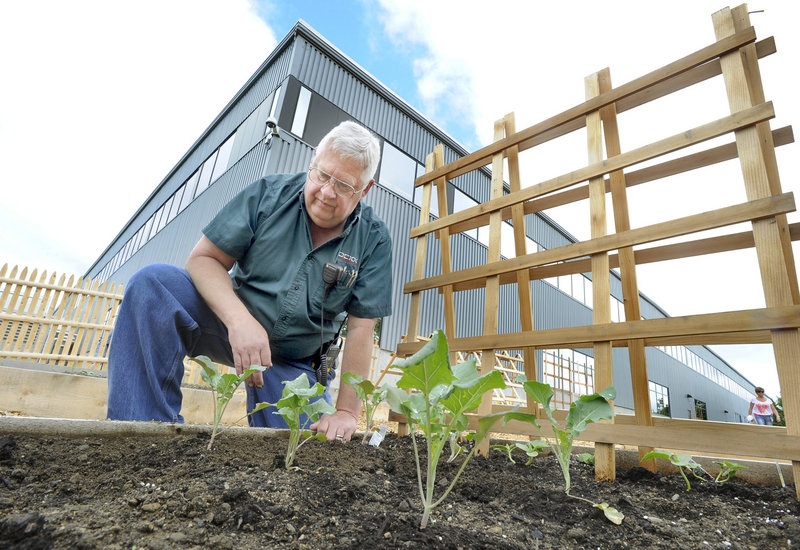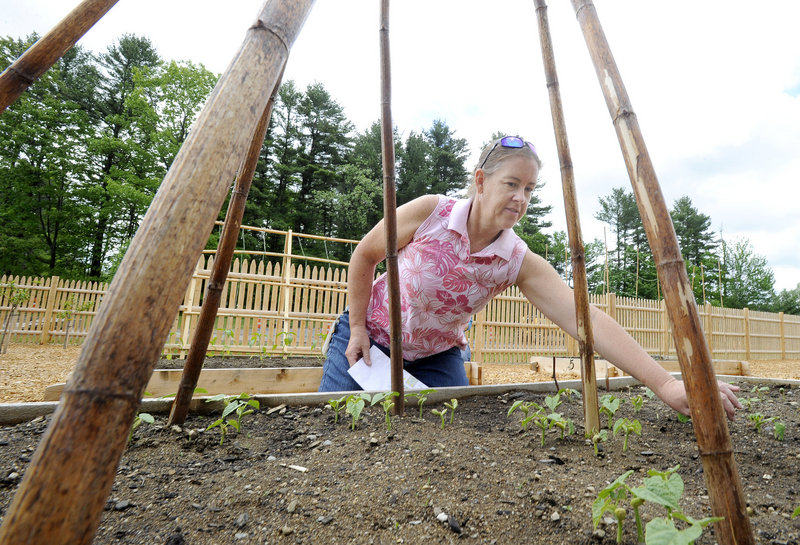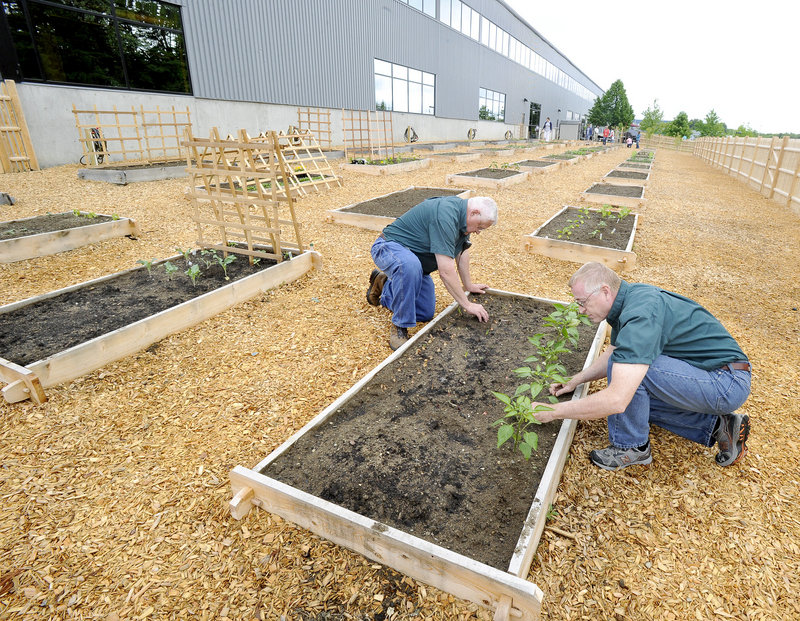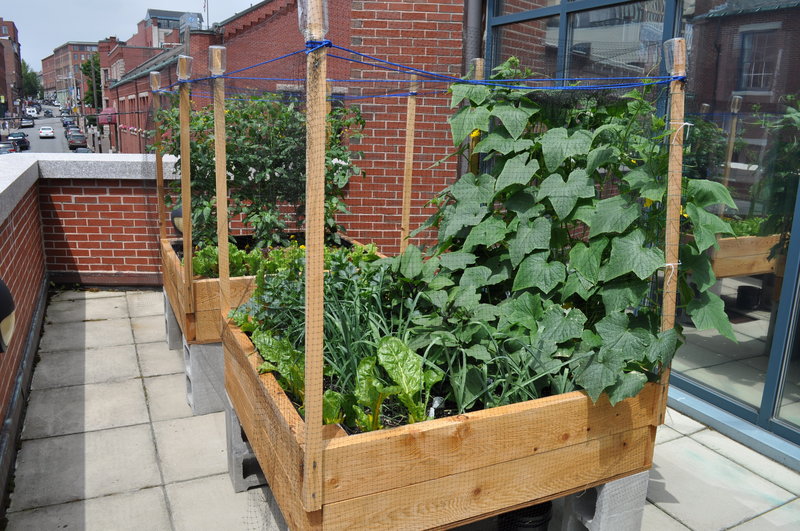For the second year, Patty Cook is gardening on company time.
A manager at Idexx Laboratories, Cook is one of hundreds of employees cultivating crops for local food pantries behind the global veterinary testing company’s sprawling corporate headquarters in Westbrook.
“We delivered to the Sagamore (Village) Food Pantry last year,” Cook said. “It was amazing to see the looks on people’s faces when we came in with bags of vegetables.”
Last year, Idexx employees grew more than 500 pounds of fresh vegetables in organic garden plots at the business, and they donated to food pantries throughout Cumberland and York counties. All this produce came from just 10 raised garden beds.
The program started because employees thought the grounds could use some sprucing up.
“We got a lot of unsolicited feedback about the appearance of the grounds,” said Idexx operations manager Matt Haas. “So we focused on the landscaping and getting people to adopt (various areas of the grounds). And then they said, ‘Can we do a garden?’ We came up with the idea in 2010, and no one could come up with a reason to say no.”
The company’s landscaping contractor, KD Landscaping, installed the raised beds and surrounded them with wood chips and a fence to keep out the deer. The orchard at the front of the garden includes 22 apple, peach and pear trees, which should begin bearing fruit in a few years.
Idexx, a publicly-traded company that employs 1,600 people in Maine and 5,000 people worldwide, started the gardening project last year.
This year, the company’s organic garden has 48 raised beds at two locations and 200 employees participating in the gardening project. Six of those beds will produce salad greens, edible flowers and herbs that will be used in the company’s cafeteria.
All the rest will be donated to the Harvest for Hunger program, which brings fresh vegetables and fruits to those in need in Maine.
FILLING A GROWING NEED
“The number of people needing assistance to get their food needs met has risen dramatically in Maine,” said Barbara Murphy, an educator with the University of Maine’s Cooperative Extension, which runs the Harvest for Hunger program (formerly known as Plant A Row for the Hungry).
According to the U.S. Department of Agriculture, about 200,000 Mainers – more than 15 percent of Maine households – are classified as food insecure, meaning they don’t always know where their next meal will come from. The number is even higher for children, with 25 percent falling into the food insecure category.
“Hunger doesn’t look like people’s images of it,” Murphy said. “It’s not swollen bellies and big eyes. In Maine, it usually represents poor nutrition, such as people not having money to buy fresh fruits and vegetables. That’s the niche Harvest for Hunger is trying to fill.”
Last year, the program collected 200,093 pounds of fresh fruits and vegetables, which it distributed to food pantries, soup kitchens and individuals. Some of the food is grown in private gardens; some comes from community garden plots. A number of farmers allow volunteers onto their farms after the harvest to glean any remaining edibles for donation to the program.
And a small but growing number of Harvest for Hunger gardens are located on corporate property.
REAPING A ROOFTOP HARVEST
In the midst of Portland’s bustling Old Port, Harvard Pilgrim HealthCare, a nonprofit health plan, is using a rooftop deck to grow organic vegetables for the Harvest for Hunger program. The raised beds were installed in 2010 and expanded in 2011 to include four planting areas.
“Last year, we donated about 63½ pounds to Preble Street (soup kitchen),” said Tony Fournier, a Harvard Pilgrim representative who coordinates the gardening effort. “That was inclusive of a lot of green and red leaf lettuce, Swiss chard, tomatoes and cucumbers.
“We were growing some really cool squash plants and they were big, but powdery mildew attacked the plants, and they stopped growing. The year before, with just two beds, we donated 72½ pounds.”
Because gardening is much more of an art than a science subject to the ever-changing whims of nature, the Harvard Pilgrim gardens face a new challenge this year: Seagulls.
The weekend before the employees were to begin planting, a pair of seagulls decided that the soft soil in one of the raised beds made a perfect nesting site. Now the nest has two speckled eggs and two very protective parents.
That particular bed will have to lie fallow until the seagulls clear out. “We’ve learned to live with them,” Fournier said.
Twenty-five employees work at Harvard Pilgrim’s Market Street office, and five of them are helping with the garden.
“The good thing about these beds is you can use them year round if you create a canopy over them,” Fournier said. “We’re planning on growing spinach throughout the winter.”
The third business growing food for the Harvest for Hunger program is the Oxford County Federal Credit Union. Its employees will be tending gardens at the branches in Norway and Mexico and donating all the produce to Harvest for Hunger.
CORPORATE GIANTS JUMP ON BOARD
Around the country, an increasing number of companies are providing space and time for employees to garden. Corporations including Google, Kohl’s and PepsiCo have started workplace gardens in recent years.
“By our count, there are certainly hundreds of companies across the United States that are doing it,” said Fred Haberman, who runs a marketing firm in Minneapolis and maintains the Employer Sponsored Gardens website (www.employergardens.com) as a resource hub for other companies looking to start gardens.
“There’s been an increase in companies that have started gardens in the last few years. I think you’re going to see a dramatic increase in the next 20 years of not just corporate gardens but rooftop gardens.”
Haberman said corporations gain a number of benefits from offering gardening programs. These include promoting healthy eating, helping the community and building better working relationships among employees.
“It’s a great engagement tool,” Haberman said. “It’s a great get-to-know you tool. You’re creating something together. How can you not at some level create a deeper relationship with your fellow worker when you do that?”
Harvard Pilgrim first planted gardens at its offices in Quincy and Wellesley, Mass., in 2009, and now advocates that other companies do the same as a way to support better employee health, reduce workplace stress and encourage collaboration with fellow employees.
Back at Idexx, where the gardens were planted two weeks ago, Loni Brown, who works in information technology, said being involved in the effort helps get her and other employees on their feet and in the fresh air more often.
“It’s also nice to meet other people from other departments,” Brown said. “Idexx is so large, our paths don’t often cross.”
Brown and the other employees on her team are growing pole beans, summer squash, carrots, onions, Brussels sprouts, cucumbers, lettuce, tomatoes and beets.
“It’s a great feeling for the community,” Brown said. “It’s easy to do, and you can see something positive coming out of it.”
PAID TIME FOR VOLUNTEERS
Each year, all Idexx employees receive 16 hours of paid time to volunteer at nonprofits, and many of the gardeners use that time to tend to the plants. Others head out to the garden during breaks, lunch or whenever they can fit in a visit.
“We’re starting our first garden at home, and this has been crucial in learning about gardening,” said Ryan Root, who is volunteering in the Idexx garden for the first time this year.
As part of Idexx’s educational series for garden participants, Root was trained as a master composter. After the training, “I went right home and took my compost all apart,” Root said. “I was doing it all wrong. If you do it right, there isn’t any smell.”
In contrast, Peter Dale has been an avid organic gardener for more than 25 years. He is one of the Idexx employees who logs onto an online company bulletin board to answer gardening questions.
“Every year is different,” Dale said. “The bugs are different. The weather is different. This year, everything is early.”
The team of which Root and Cook are part is growing basil, broccoli, tomatoes, spinach, Swiss chard, lettuce, cucumbers, radishes and hot peppers.
“Hot peppers were a big hit last year,” Cook said. “The Sagamore Food Pantry gave us a list of what people liked, and that’s what we’re growing.”
The team plans to do multiple plantings this season, ensuring a steady harvest through the fall.
“It’s fun to get together and come out here and mess around,” Cook said. “It broke down barriers among co-workers.”
According to Amy Witt, a Cooperative Extension horticulturist who helped Idexx start the Harvest for Hunger gardens, the company has reaped numerous benefits.
“Not only are they filling a need, but at Idexx they’ve developed some really good relationships,” Witt said. “It’s really helped with the Idexx employees. It’s really strengthened them as employees and work teams. The employees find themselves to be more productive.
“It’s been a win-win for a the business and a win-win for the people who need the food.”
Staff Writer Avery Yale Kamila can be contacted at 791-6297 or at: akamila@pressherald.com
Twitter: AveryYaleKamila
Send questions/comments to the editors.





